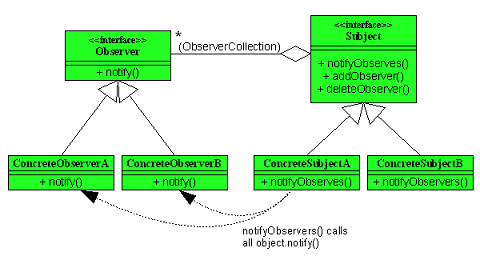1、观察者设计模式定义:观察者模式定义了对象之间的一对多依赖,这样一来,当一个对象改变状态时,它的所有依赖者都会收到通知并自动更新。
2、观察者设计模式的UML类图:

3、关键字
- Observable
即被观察者,也可以被叫做主题(Subject)是被观察的对象。通常有注册方法(register),取消注册方法(remove)和通知方法(notify)。 - Observer
即观察者,可以接收到主题的更新。当对某个主题感兴趣的时候需要注册自己,在不需要接收更新时进行注销操作。
4、代码实现:
举一个生活中的例子:比如用户从报社订阅报纸,报社和用户之间是一对多依赖,用户可以在报社订阅(register)报纸,报社可以把最新的报纸发给用户(notify),用户自动收到更新。在用户不需要的时候还可以取消注册(remove)。
再比如Android中的EventBus,Rxjava的实现都是基于观察者模式的思想。再比如回调函数:Android中对Button的点击监听等等。
观察者模式可以用来解耦
Servlet中的Listener就是典型的事件驱动模型。
JDK中有一套事件驱动的类, 包括一个统一的监听器接口和一个统一的事件源,源码如下:
/**
* A tagging interface that all event listener interfaces must extend.
* @since JDK1.1
*/
public interface EventListener {
}
这是一个标志接口, JDK规定所有监听器必须继承这个接口。
public class EventObject implements java.io.Serializable {
private static final long serialVersionUID = 5516075349620653480L;
/**
* The object on which the Event initially occurred.
*/
protected transient Object source;
/**
* Constructs a prototypical Event.
*
* @param source The object on which the Event initially occurred.
* @exception IllegalArgumentException if source is null.
*/
public EventObject(Object source) {
if (source == null)
throw new IllegalArgumentException("null source");
this.source = source;
}
/**
* The object on which the Event initially occurred.
*
* @return The object on which the Event initially occurred.
*/
public Object getSource() {
return source;
}
/**
* Returns a String representation of this EventObject.
*
* @return A a String representation of this EventObject.
*/
public String toString() {
return getClass().getName() + "[source=" + source + "]";
}
}
EvenObject是JDK给我们规定的一个统一的事件源。EvenObject类中定义了一个事件源以及获取事件源的get方法。